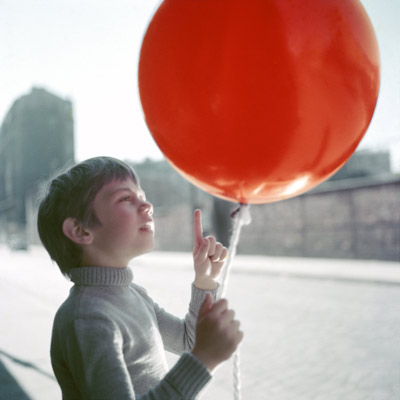The Red Balloon and White Mane Kick Off Summer Cinema at UCSB
Arts & Lectures Presents Albert Lamorisse Double Feature at Campbell Hall

As a child of the ’80s, film and television played a sizable role in even my earliest of years. I recall watching E.T. phone home in a dark theater as a tiny tot, and I remember my beloved Beta collection. Specifically, there were two of these short, stocky, and horrifically unreliable cassettes that I can recall watching on loop throughout most of my toddlerhood: Jim Henson’s The Tale of the Bunny Picnic and Albert Lamorisse’s The Red Balloon. Looking back, the former likely appealed to my wildest childhood dream, when all of my stuffed animals would come to life, do a little song and dance, and throw a massive feast in some Henson-ized fairytale meadow. As for my infatuation with the latter, well, it’s a bit more complicated.
Lamorisse’s 34-minute tale of a boy named Pascal and his red balloon features almost no dialogue, with the small amount of it being spoken in French. The cinematography is startling, the color contrasts dazzling, and the underlying message is the one of the more debatable topics in French film lore. Against a sky of gray and a washed-out Parisian backdrop, Pascal’s balloon creates a luminous beacon of hope and wonder. As the film goes on and the balloon develops agency, it becomes a floating symbol of a very reachable dream for a youngster living in post-Word War II misery, only to be crushed by a spiteful gang of bullies.
Still, Lamorisse’s attention to cinematic detail is wrapped inside a delightfully simplistic plotline: Boy finds balloon, boy befriends balloon, balloon becomes the envy of the neighborhood, neighborhood destroys balloon. In essence, it’s an age-old tale that any kid with siblings can relate to, and its ending-at least in Lamorisse’s world-is the stuff five-year-olds’ fantasies are made of.
First released in the U.S. back in 1957, the story of young Pascal and his balloon has gone on to delight generations, even spawning a less-than-successful full-length adaptation in 2007’s Le Voyage du Ballon Rouge, starring Academy Award winner Juliette Binoche. And as of 2008, Lamorisse’s Balloon was re-released in all its newly digitized glory, thanks to the power of DVD. The disk also features Lamorisse’s 1953 classic, White Mane, which tells the tale of a young fisherman who defies all odds-and narrowly escapes death-to befriend and tame a wild stallion.
Set in the picturesque marshes of Camargue, France, Mane pits a preteen boy named Folco against a team of brutal ranchers in a fight to capture the elusive (and aggressive) White Mane. Unsurprisingly, Folco’s determination and kindness win out over the ranchers’ antagonism and violence, and eventually the tamed steed and the young boy become best of friends. Predictable as the story may be, Lamorisse’s black-and-white short startles even on the small screen. Set almost exclusively in Camargue’s marshlands, the numerous chase scenes are an exercise in cinematic precision that results in almost otherworldly shots of horses seemingly racing on water. The soundtrack is orchestral and minimalist, calling out to the live-action Disney shorts of the ’50s, and the narration (provided by Frank Silvera) is caught somewhere between Planet Earth and a Greek chorus.
The stories, as divergent as they appear, are rooted by Lamorisse’s signature happy endings. And as contrived, idealistic, and naive as they may seem, they’re also the stuff good children’s films are made of-and the reason why a 30-minute French short about balloons can stick with a kid long into her adulthood.
4•1•1
The Red Balloon screens alongside White Mane this Wednesday, July 8, at 7:30 p.m. as part of UCSB’s Arts & Lectures Summer Cinema series at Campbell Hall, with children’s tickets available at discount. Call 893-3535 or visitartsandlectures.ucsb.edu for info.



